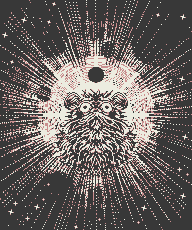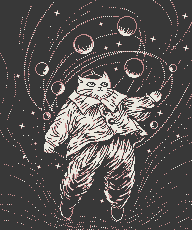Cosmogony

Cosmogony is an epic poem penned by the Poet, narrating the myths surrounding the origin of the Universe. The tale centers on two primeval beings, the Fool and the King, whose interaction and resultant balance birthed the Cosmos known to critters today.
The Primordial Myth
Initially, chaos and disorder reigned. From this primary state, the Fool arose-a seemingly ordinary figure equipped with the inherent ability to juggle chaos's raw elements. As the ~Cosmic Juggler,~ the Fool manipulated and organized these elements, forming intricate patterns that eventually coalesced into various celestial bodies and entities of the universe.
In parallel, the King, a timeless figure afflicted by madness, emerged from the primordial order. As the ~Cosmic Shuffler,~ the King symbolized the transformation of order into chaos, a stark contrast to the harmonizing force of the Fool. Their opposing energies shaped the universe through the eternal dance of the Fool and the King.

The Cosmic Dance
The cosmic dance between the Fool and the King underpins the universe's fundamental forces, as their constant interplay fosters both order and chaos. As they dance, their combined energies birth new celestial bodies, phenomena, and life itself. This delicate balance allows the universe to continuously evolve and prosper. In the Cosmogony, various allegorical interpretations represent the Fool and the King's dance, emphasizing the cyclical nature of creation and destruction and the need for both forces to sustain the universe's equilibrium.
The First Critters
As the poem unfolds, the Poet delineates the birth of the First Critters--mythical creatures that populated the universe at the dawn of time. Emerging from the interplay of the Fool and the King, these critters manifested their combined energies and facilitated the universe's prosperity by providing conditions conducive to the emergence of life.
The Elusive Vulpes
Among the First critters was the Fate, a mystical vulpes that remained ever elusive. This swift creature held the secrets of destiny within its paws, darting through the Cosmos and weaving the fabric of fate. The uncatchable nature of the Fate created an initial quandary when faced with the Fall, a mighty canis capable of capturing any living thing.
The Mighty Canis
The Fall was a formidable canis, renowned for its hunting prowess, capable of capturing any living creature. It sought out those who dared to defy their destiny, ensuring that the cosmic order remained intact. The pursuit of the Fate by the Fall symbolized a falling object that never encounters the ground (the Fate), creating a conundrum when an unstoppable force meets an uncatchable being.
The All-Seeing Bubo
The Time, a wise bubo, was another mythical critter bestowed with the ability to witness every event throughout the universe. However, the Time's capability posed a paradox, as it could neither observe the Fate being captured by the Fall nor the Fate escaping from the Fall. This impossibility underscored the pursuit as a paradox that couldn't occur in the presence of the Time, but only as an action unfolding in the presence of Time.
The Cosmic Egg
The complex dilemma formed by the interactions of the Fate, the Fall, and the Time disrupted the natural order maintained by the Cosmic Dance. Their eternal struggle ultimately led to their transformation into statues, forever immortalized as celestial constellations in the sky: Canis Major/ Sharvara (the Fall), Canis Minor/ Shyama (the Fate), and Orion/ Mriga (the Time). As a result of the primordial paradox, reality fractured into multiple planes. The persistent reality, known as the ~World,~ represented a coherent and continuous order of things. The other planes, referred to as the ~Log,~ documented an ever-evolving record of the World, chronicling the countless celestial formations and patterns emerging from the Cosmic Dance.
The Forgers' Cantos
The poem concludes with seven cantos dedicated to all the known forgers, the mystical figures who operate the Log as a Cosmic Palimpsest. The first canto highlights the Fake as the Master Forger, who brings all things into existence within the Log. The second canto describes the Loop as the Cycle Forger, who ensures the wheels of time continue turning. The third canto features the Maze as the Path Forger, who maintains reality's coherence. The fourth canto illuminates the Word as the Seed Forger, who shapes the minds of critters. The fifth canto elaborates on the Silk as the Dream Forger, who crafts the dreams of critters. The sixth canto introduces the Dark as the Shadow Forger, who protects the realms' boundaries. The seventh canto concludes with the Melt as the Time Forger, the one who bends Reality.